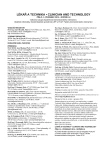Impact of different heart rates and arterial elastic moduli on pulse wave velocity in arterial system model
The article describes the analysis of a pulse wave propagating through arteries towards periphery. For this analysis the model of arterial system based on the electromechanical analogy was used. Using the theory of transmission lines we estimated phase and group velocity of the arterial pulse wave. Both types of velocities were compared and dispersive properties of the selected arterial segments were evaluated. Pulse wave velocity corresponding to group velocity was calculated. We performed simulations for different heart rates and for different arterial elastic moduli. An increase in the heart rate causes that phase and group velocities converge to the same values. The higher magnitude of the arterial elastic module has the impact in the form of the increase in the both types of pulse wave velocities indicating the pathological state of the arterial system – arteriosclerosis.
Keywords:
arterial system, group velocity, modelling, phase velocity, pulse wave
Autoři:
Stefan Borik; Ivo Cap
Působiště autorů:
University of Zilina, FEE, Dept. of Electromagnetic and Biomedical Engineering, Zilina, Slovakia
Vyšlo v časopise:
Lékař a technika - Clinician and Technology No. 4, 2014, 44, 25-27
Kategorie:
Původní práce
Souhrn
The article describes the analysis of a pulse wave propagating through arteries towards periphery. For this analysis the model of arterial system based on the electromechanical analogy was used. Using the theory of transmission lines we estimated phase and group velocity of the arterial pulse wave. Both types of velocities were compared and dispersive properties of the selected arterial segments were evaluated. Pulse wave velocity corresponding to group velocity was calculated. We performed simulations for different heart rates and for different arterial elastic moduli. An increase in the heart rate causes that phase and group velocities converge to the same values. The higher magnitude of the arterial elastic module has the impact in the form of the increase in the both types of pulse wave velocities indicating the pathological state of the arterial system – arteriosclerosis.
Keywords:
arterial system, group velocity, modelling, phase velocity, pulse wave
Zdroje
[1] S. Borik, I. Cap, Investigation of pulse wave velocity in arteries, 35th International Conference on Telecommunications and Signal Processing (2012), 562-565.
[2] S. Borik, I. Cap, Implementation of wireless data transfer to photoplethysmographic measurements, ELEKTRO 2012 (2012), 407-410.
[3] E. W. Gaelings, Numerische Simulation hämodynamischer Prozesse in vaskulären Netzen, Shaker, 1996.
[4] S. Borik, I. Cap, Nondestructive evaluation of arterial system properties using electromechanical analogies and light based diagnostic methods, Studies in Applied Electromagnetics and Mechanics, 39 (2014), 85-92.
[5] A. P. Avolio, Multi-branched model of the human arterial system, Medical and Biological Engineering and Computing 18.6 (1980), 709-718.
[6] D. Gombarska, B. Czippelova, Computer simulation of human cardiovascular system, Acta Technica 57.4 (2012), 407-420.
[7] Guyton, Arthur C. Textbook of medical physiology. Vol. 762. Philadelphia: Saunders, 1971.
[8] Lonngren, Karl Erik, Sava Vasilev Savov, and Randy J. Jost. Fundamentals of Electromagnetics with MATLAB. Scitech publishing, 2007.
[9] Lehnert, Bo. A revised electromagnetic theory with fundamental applications. Swedish Physics Archive, 2008.
[10] Brillouin, Léon. Wave propagation and group velocity. Vol. 960. New York: Academic Press, 1960.
[11] K. Takazawa, et al., Assessment of vasoactive agents and vascular aging by the second derivative of photoplethysmogram waveform, Hypertension, 32.2 (1998), 365-370.
[12] W. A. Riley, et al, Ultrasonic measurement of the elastic modulus of the common carotid artery, The Atherosclerosis Risk in Communities (ARIC) Study. Stroke 23.7 (1992), 952-956.
Štítky
BiomedicínaČlánok vyšiel v časopise
Lékař a technika

2014 Číslo 4
Najčítanejšie v tomto čísle
- REAL-TIME visualization of multichannel ECG signals using the parallel CPU threads
- Differences in sleep patterns among healthy sleepers and patients after stroke
- Pulmonary fluid accumulation and its influence on the Impedance Cardiogram: CompariSON Between a Clinical Trial AND FEM Simulations
- EFFECT OF THE PLACEMENT OF THE INERTIAL SENSOR ON THE HUMAN MOTION DETECTION
